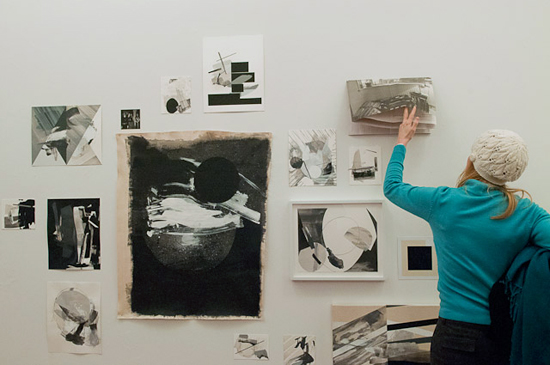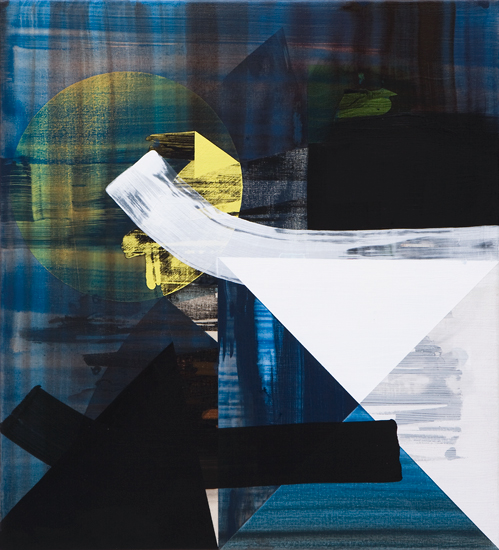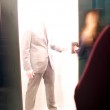Vince Contarino is a New York based painter. His multi-layered canvasses explore the language of abstraction. From first glance there is something illusive in Contarino’s canvases, a tension between the forthright and the concealed. The artist often repurposes forgotten brushstrokes and colors, pasting them into his collages and works on paper. The result is something both beautiful and challenging, a floating soup of the painterly. Contarino’s belief in the ongoing relevance of abstraction is mirrored in his extracurricular activities. His most recent curatorial project, “The Working Title”, organized with painter Kris Chatterson, opens at the Bronx Art Center next Friday. I recently had the chance to speak with the artist over the phone.
HH: Perhaps you could tell our readers a little about yourself. When did you start painting, how are your recent works different from the older ones?
VC: I made a conscious decision to move to NYC and become a painter right after receiving my undergrad from the Ringling School of Art & Design, near where I grew up in Sarasota, FL. It was an eye-opening experience, and I was pretty much starting from scratch in terms of developing work that I could call my own.
I’ve always been interested in the idea of seeing the artist’s hand in paintings, but also respond to work that involves conceptual thought and decision-making. There is a certain trance-like state that we all enter to varying degrees when we make our work, but I am invested in balancing that with more conscious thinking about the marks I make and the relationships they have to each other in the paintings.
Having a simple approach is important to my process. I love the economy of drawing with pencil on paper and the free-handed unpredictability of translating those ideas into my paintings, that in the earlier work were more directly fluid.
I worked for years like this until I eventually took a break from this approach and began making collage works on paper composed of discarded marks that opened up a more assertive and investigative way to expand the language of my paintings.
HH: To paint abstract today is a loaded activity and can mean so many things. Do you feel the pressure of previous generations?
VC: I think artists working with abstraction today have the advantage of hind sight, and rather than being intimidated or exhausted by the weight of history, these conversations with previous generations offer a variety of methods in developing your own voice. When I look back at the hard-lined stances of particular movements of those that came before us, there is a pattern of reactionary abandonment, or dismissal of certain approaches by the latest generation in order to move things forward.
What is happening now feels like it takes on a less defensive stance on making art, and encourages the freedom of working in an open dialogue with the past, seeking out and elaborating on previous approaches that may have been have marginalized or forgotten.
HH: I am especially drawn to your acoustic series, along with your recent collages which seem to be a point of departure in your painting. Can you speak to these works, where did they come from?
VC: I started the acoustic series over the summer as a way to further explore using discarded marks in a limited setting. Kind of similar to how a singer/songwriter might come up with a new song on an acoustic jam.
Some other things on my mind while working on this project have been the lingering effect of early cinema, particularly Film Noir, cut-and-paste DIY punk show flyers, and a desire to create this ever-evolving black shrine that I can reference when working on my paintings.
The removal of color gives them the preliminary quality of a drawing while searching for ideas through value, texture and placement. Instead of attempting to reinvent form, I’m left with works that create a visual dialogue based on my collections of shapes and gestures. I prefer to allow the complexity to reveal itself in the process by creating depth on a flat surface and organizing the finished works through various configurations in my studio.
HH: What part does editing and self selection play in your work?
VC: An important part of my studio practice involves searching for casual gestures and pairing them with more deliberately constructed forms. While there is room for chance and discovery, I try to operate in a middle ground that is neither restrictive or self indulgent, continually editing down the paintings to their most important elements.
HH: Let’s talk about your upcoming show, The Working Title. What gave you the motivation to start curating shows? Why abstraction?
VC: This show in particular came out of an online project called Progress Report, that I co-founded with painter Kris Chatterson. It is dedicated to artist features, studio visits and is intended as a curatorial resource for ourselves and others. We wanted to create something that was highly visual, had a more editorial, photo-journalistic feel, and would give our readers a glimpse of the creative process from the working artist’s perspective.
Both Kris & I are interested in the elasticity and possibilities of abstraction in our own work and were offered the opportunity to put this show together based on the work we were featuring on Progress Report.
The organization of this exhibition was specific about arranging contrasting approaches that would encourage unpredictable relationships from a curatorial perspective. Minimalism, post-modern, geometric, gestural, formal, process-driven works occupying the same space. Our feeling is that artists are now more able to work as painstakingly detail-oriented, gesturally-free, or conceptually focused as they please, employing and breaking systems to be absorbed and enter into the work.
HH: How do you feel curating ties into your artistic practice? Are there tie ins from the studio or vice versa?
VC: One of the best things about living in NYC is the direct access you have to other artists through studio visits. The art world can be a hyper-social place where real connections and critical conversations are hard to come by. While we were both already exchanging studio visits, Progress Report was instrumental in meeting artists that we respected and our artist features acted as a time capsule of what others were making in the moment. Staying active and interested in what your peers are making and being dedicated to your work is a healthy extension of your own practice.
HH: When and why did you start Progress Report?
VC: Progress Report was founded just over a year ago, and born out of my contributions to an online visual journal, started by Kris Chatterson called KCLOG that was a log of all the exhibitions we were seeing throughout NYC. We were particularly invested in the increasing number of artist-organized shows that started appearing during the recession of the past few years.
Being in the NYC hotbed of chaotic, creative energy…your work improves (or not) at a pretty rapid pace. The single most important part about living here for me has been the support and intellectual exchanges with my peers. The art world is a business, and should be treated as such, but the relationships you share with other creatives are the ones that you must nurture and develop, as they have made the same commitment and sacrifices you have in deciding to live the life of an artist.
There are only a handful reliable registries that give us exposure and offer opportunities, so we wanted to start something that was more invested in giving a deeper understanding of the artists, their process, and why they make the work that they do. Keeping this self-generated approach as the focus of our project by supporting other artists’ work in tandem with the artworld-at-large, was and remains the impetus for Progress Report.
HH: Can you tell us about the recent initiative, artists selecting artists. ( Does this new Progress Report initiative have a name?)
VC: The idea for Progress Report from the beginning, was to get other artists more involved in who was being featured on the site. To this end, we came up with a new section called “Take Five”, an opportunity for previously featured artists to feature five artists of their choosing that would allow the project to generate new content in an organic way and give the site a more diverse feel.
Artist Websites -







 RSS
RSS

“The art world can be a hyper-social place where real connections and critical conversations are hard to come by… Staying active and interested in what your peers are making and being dedicated to your work is a healthy extension of your own practice…The art world is a business, and should be treated as such, but the relationships you share with other creatives are the ones that you must nurture and develop, as they have made the same commitment and sacrifices you have in deciding to live the life of an artist.”
Agreed.
Thank you both for the great interview.
March 23, 2011 @ 9:34 pm
This is a wonderful interview and also very helpful to me as an artist living in the UK. Here it’s sometimes hard to make meaningful connections with other artists unless you are working in a studio complex. I lived in Cyprus and artists tended to get together a lot more and discuss their work. Relating to one’s peers has always seemed very important to me, and I never cease to have respect for other artists and the life choices they have made. I’ve found Facebook a very good way to exchange artistic ideas with other artists.
I love these paintings and reading about the ideas behind them.
March 29, 2011 @ 8:04 am